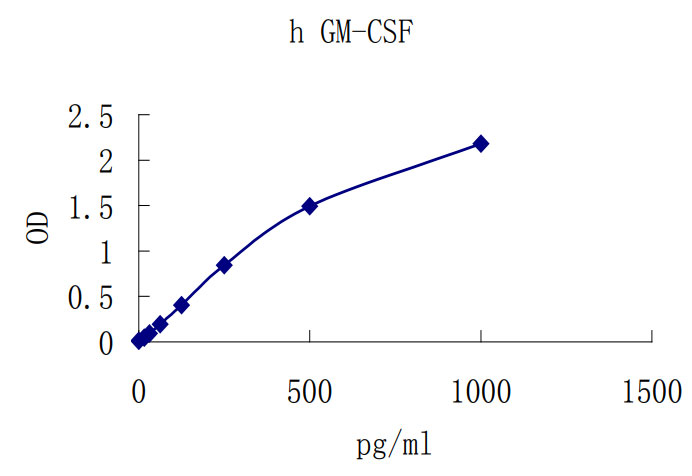Granulocyte macrophage colony stimulating factor (GM-CSF) is a pleiotropic cytokine with multiple effects on hematopoietic cells (1-4). It mobilizes CD34+ progenitor cells into the periphery and stimulates their proliferation, survival and differentiation into neutrophils,monocytes/ macrophages, eosinophils, and myeloid dendritic cells (4-8). On these terminallydifferentiated myeloid cells, GM-CSF is also needed for inducing their effector functions (7-10). In addition, GM-CSF has been shown to stimulate the proliferation and differentiation of the erythroid and megakaryoctye progenitor cells (4).
GM-CSF is produced by a number of different cell types, including keratinocytes, mature and immature NK cells, type II alveolar cells), endothelial cells, monocytes, bone-marrow mesenchymal stem cells, CD4+ and CD8+ T cells, megakaryocytes, B cells, eosinophils, chondrocytes and fibroblasts.
Human GM-CSF cDNA encodes a 144 amino acid (aa) residue precursor protein with a 17 aa putative signal peptide and a 127 aa mature protien (11 - 13). Natural GM-CSF is a monomer that contains both N- and O-linked glycosylation (14). Mature human GM-CSF shares approximately 55%, 63% and 68% aa sequence homology with mouse, rat and canine. GM-CSF, respectively. Human GM-CSF is not biologically active on mouse cells (11), but was reported to have some activity on canine cells (15).
GM-CSF exerts its activity through binding to a high affinity receptor complex consisting of two membrane glycoproteins. The presence of the spliced variants in the heteromeric receptor complex can regulate the functions of the complex (16).
Lieschke, G.J. and A.B. Burgess (1992) N. Engl. J. Med. 327:28.
Armitage, J.O. (1998) Blood 92:4491.
Baldwin, G.C. (1992) Dev. Biol. 151:352.
Hill, A.D.K. et al. (1995) J. Leukoc. Biol. 58:634.
Metcalf, D. (1986) Blood 67:257.
Gazitt, Y. (2002) Curr. Opin. Hematol. 9:190.
Gilliet, M. et al. (2002) J. Exp. Med. 195:953.
Basak, S.K. et al. (2002) Blood 99:2869.
Jablonska, E. et al. (2002) Melanoma Res. 12:123.
Metcalf, D. et al. (1986) Blood 67:37.
Cantrell, M.A. et al. (1985) Proc. Natl. Acad. Sci. USA 82:6250.
Wong, G.C. et al. (1985) Science 228:810.
Lee, F. et al. (1985) Proc. Natl. Acad. Sci. USA 82:4360.
Smith, L.R. et al. (1994) Immunogenetics 39:80.
Nash, R.A. et al. (1991) Blood 78:930.
Wagner, K. et. al. (2001) Blood 98:2689.

